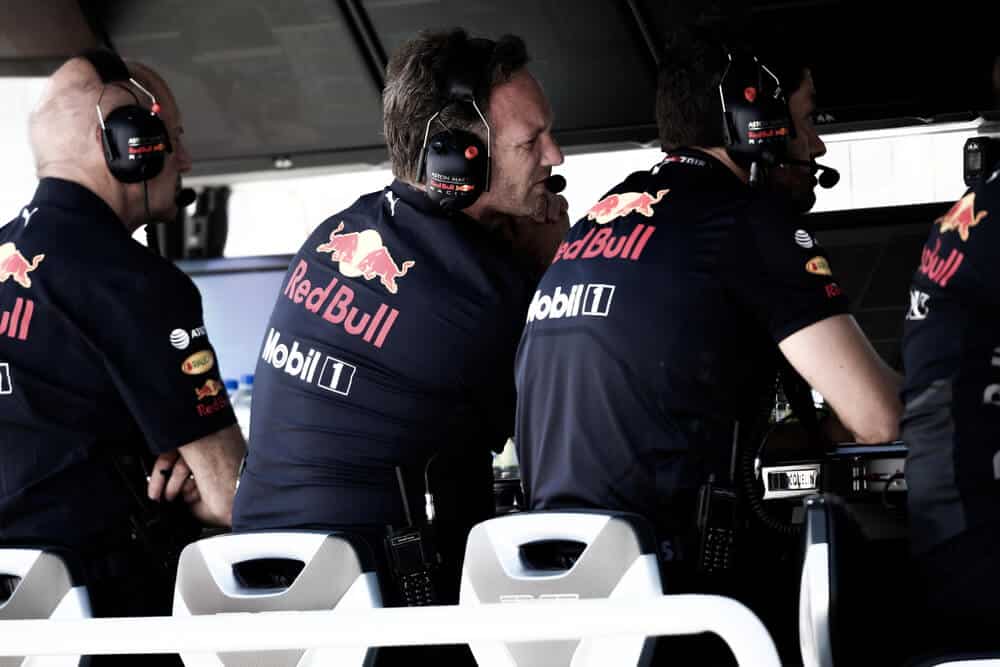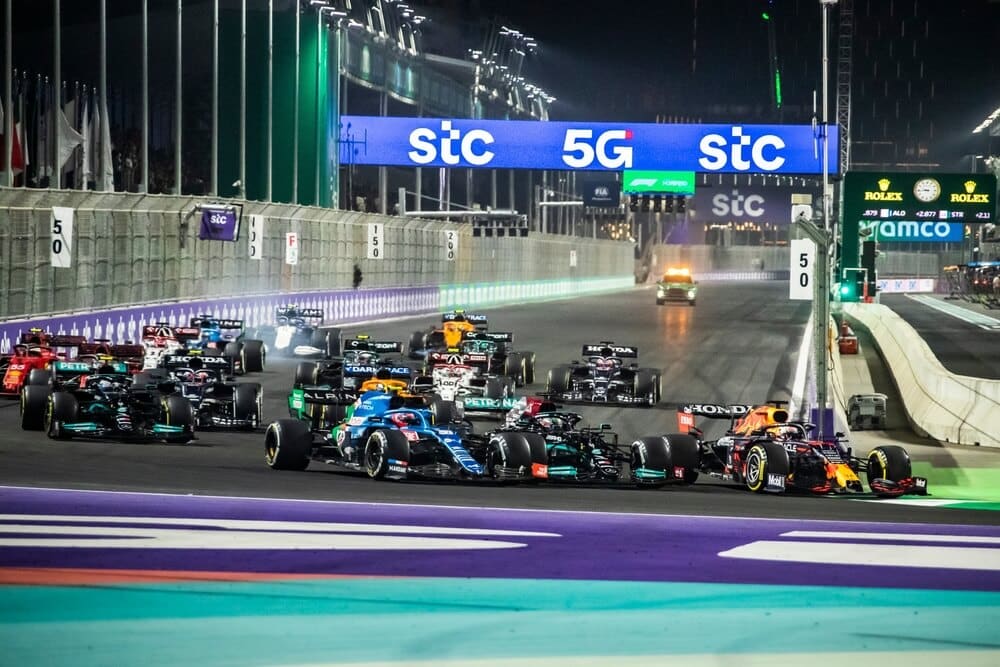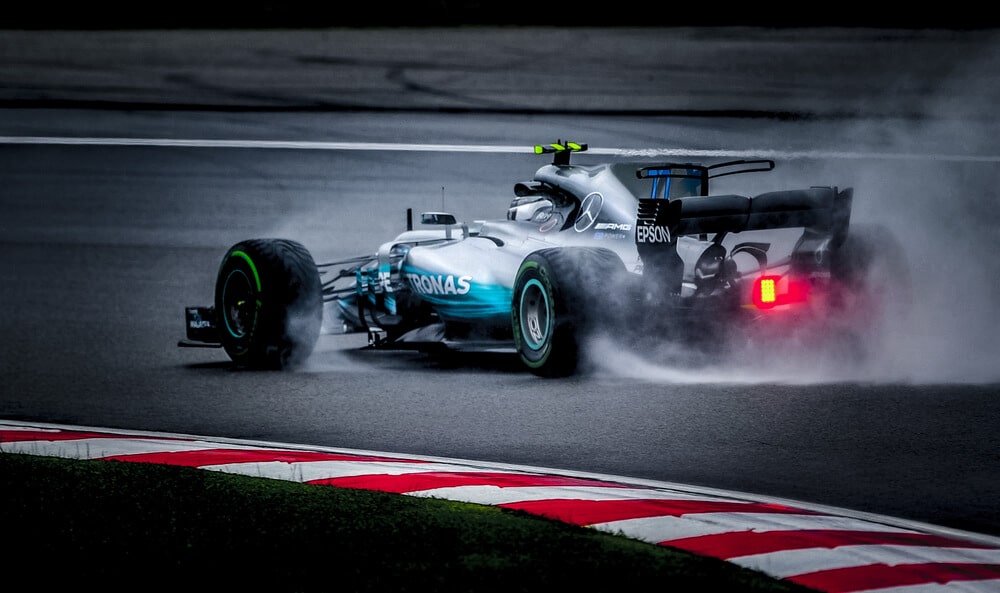The thrill, hair-raising excitement and adrenaline one experiences with every turn of the cars, racing for the lead, during a motorsports championship are unmatched.
Formula 1 and Formula E are well-known terms in motorsport championships. To the casual spectator, both cars may appear to be the same. However, there are some essential differences between the two.
To fully understand the difference between the two, we must go deeper into the basics. Keep reading to find out how Formula 1 and Formula E differ.
Table of Contents
What is the difference between Formula 1 and Formula E?
The major difference between the two, apart from one being the pinnacle of motorsport championships and the other like the new kid in town, is that Formula 1 is fuel-driven while Formula E cars are racing towards a cleaner future with their all-powered electric engine.
The table below categorizes the main differences between a Formula 1 car and a Formula E car.
| Formula 1 | Formula E | |
|---|---|---|
| Chassis | Various Manufacturers | Spark Racing Technology |
| Power Unit | 1.6-liter turbocharged hybrid V6 | 54 kWh Battery |
| Weight | 798 kg | 900 kg |
| Length | 5500 mm | 5160 mm |
| Width | 2000 mm | 1770 mm |
| Max Power | 745+ kW / 1000+ HP | 250 kW / 335 HP (in Fanboost mode) |
| Top Speed | 340+ kph / 210+ mph | 280 kph / 174 mph |
| 0-60 mph | 2.6 seconds | 2.8 seconds |
| Race Length | 305 km / 190 miles | 45 mins + 1 lap |
Key Takeaways
Here is a list of some key differences between Formula 1 and Formula E:
- Formula 1 car has a massively powerful 1.6L turbocharged V6 engine coupled with a hybrid system. On the contrary, the electronic motor is powered by a 28kWh battery in Formula E.
- Formula 1 cars generally weigh approximately 80kg lighter than Formula E, which weighs around 900kg.
- Formula 1 has a maximum speed of 210 mph, while Formula E cannot exceed 174 mph.
- Spark Racing Technologies is the sole manufacturer of Formula E. On the contrary, there are various manufacturers of F1, for instance, Mercedes, Ferrari and Renault.
- Formula E can go from 0-100km/h in 2.8 seconds, whereas Formula 1 reaches the same speeds in an impressive 2.6 seconds.
- Fuel engines power F1 cars, creating more power than electric motors. They have a horsepower of 1000+, while Formula E automobiles fire up around 335 horsepower.
What is the difference between Formula 1 and Formula E?
The major difference between the two, apart from one being the pinnacle of motorsport championships and the other like the new kid in town, is that Formula 1 is fuel-driven while Formula E cars are racing towards a cleaner future with their all-powered electric engine.
The table below categorizes the main differences between the two.
| Formula 1 | Formula E | |
|---|---|---|
| Chassis | Various Manufacturers | Spark Racing Technology |
| Power Unit | 1.6-liter turbocharged hybrid V6 | 54 kWh Battery |
| Weight | 798 kg | 900 kg |
| Length | 5500 mm | 5160 mm |
| Width | 2000 mm | 1770 mm |
| Max Power | 745+ kW / 1000+ HP | 250 kW / 335 HP (in Fanboost mode) |
| Top Speed | 340+ kph / 210+ mph | 280 kph / 174 mph |
| 0-60 mph | 2.6 seconds | 2.8 seconds |
| Race Length | 305 km / 190 miles | 45 mins + 1 lap |
Understanding a Formula 1 Car
Even though F1 automobile racing has roots in the European Grand Prix Championship of the 1920s, the 1950s was the decade of successful front-engined racing cars, especially in sports-car racing.
A modern Formula 1 car can best be described as the peak of engineering excellence. With an engine, also known as a power unit, positioned behind the driver, a Formula 1 car is a single-seater, open cockpit, open-wheel formula racing car.
The F1 cars must be constructed using the most advanced materials and techniques to withstand their remarkable physical strain during the world’s most popular motor racing sports.
Let us dig deeper and see more of its specifications.
Weight
F1 cars are mostly made from carbon fiber and other strong but lightweight materials.
Including the driver and wheels, while excluding the fuel, the weight of an F1 car should not be less than 702kg or 1548lbs. Having a minimum weight of 150kg, the engine is the most massive component in an F1 car.
Maximum power
The latest power plant in F1 cars is its most complex yet, with a massively powerful 1.6L turbocharged V6 engine coupled with a hybrid system that includes a petrol engine as well as electric power, better known as an energy recovery system (ERS). The whole thing, petrol and electric, put out 1000 horsepower, which is very high compared to normal road cars.
Moreover, Formula 1 can produce around 680Nm of torque.
0-100 km/h.
The petrol engine revs up to 15000 rpm with its 8-speed automatic gearbox, which means 0-100km/h in 2.6 seconds.
Max speed
F1 cars are known to produce high speeds, making them the most powerful, most technologically advanced and fastest cars in the world. They have reached top speeds hitting a blistering 230mph or 340kph. The highest speed ever recorded for an F1 car was 246.9mph.
Due to their high speeds, F1 cars take only 1.7 seconds to finish the century sprint.
Fuel
Formula 1 car uses normal fuels with no specific power-boosting compounds. However, 10% of it must be advanced sustainable ethanol.
They use about 75 liters of fuel per 100km. 110liters of fuel, at most, can be used in a race.
Wheels
F1 cars are open wheels, which means they are exposed to the air and are situated away from the automobile.
Pirelli is the official tire supplier for Formula 1 cars. F1 cars have smooth, slick 13-inch wheels with no treads to provide a better grip on the track surface in dry conditions.
However, there are two more types of tires that the F1 teams can utilize, one being the intermediate tire set for light rain or dampness and the full wet tire set for heavy rain.
Noise
An automobile may seem faster and more powerful solely because of the sound it produces.
A formula 1 car typically generates very loud sound reaching up to 138 decibels of sound, just below the level that causes permanent hearing loss.
Steering Wheel
The steering wheel of a Formula 1 car consists of more than two dozen buttons, knobs, rotary dials, menus, displays and LEDs, which are equipped to perform various functions such as changing brake pressure, changing gears, fuel adjustment and calling the radio.
Braking System
The braking system of an F1 car comprises brake discs, calipers, pedals and master cylinders. All the components are linked by pipework and with a brake-by-wire unit controlling the rear brakes.
The brakes limit their ability to deliver even greater performance, even with the deacceleration.
The brake discs are 32mm thick on the front and 28mm on the back. There are up to 1480 ventilation holes in the discs, each 2.5mm in diameter.
Manufacturer
Due to the complex nature of Formula 1 engines, only Mercedes, Ferrari, Renault, and Honda currently manufacture them.
Race Criteria
Formula 1 races along custom-built out-of-town circuits, which are wide, long, fast, and complex. An average distance of 300 kilometers is covered by a Formula 1 driver in a single race.
In an F1 team, there are two drivers, each with one car.
Formula 1 Grand Prix stretches between 3 days, where practice and qualifying occur in the days leading up to the race.
Pit Stops
Pits stops are an integral part of any race. Depending on various factors, such as track conditions, weather and car damage, cars take between one to three pit stops in a race.
However, pit stops are made primarily for changing tires, and F1 drivers must stop at least once in a race.
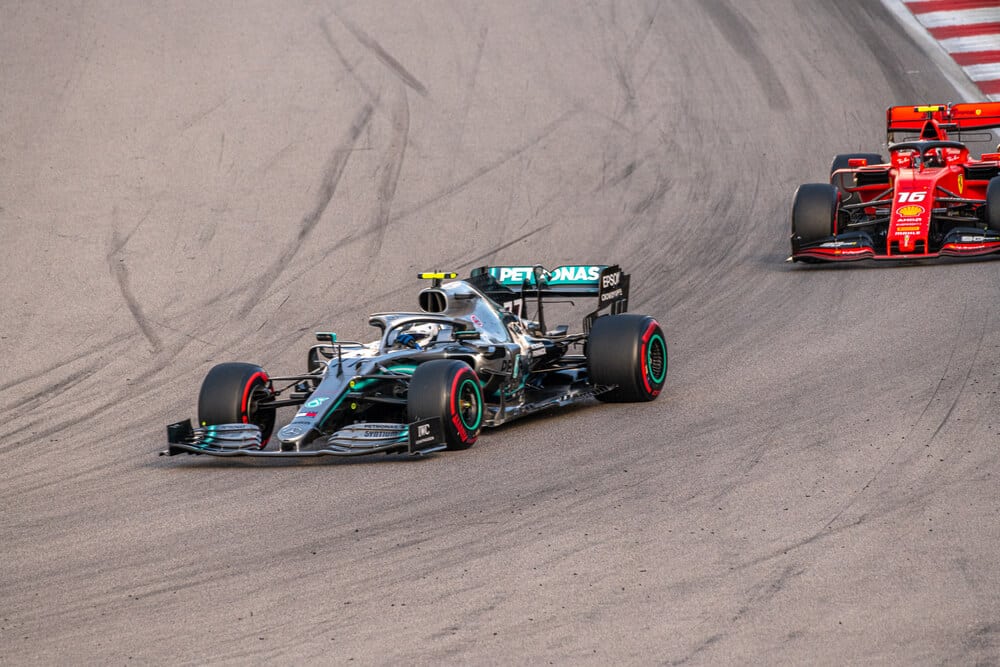
The major difference between the two, apart from one being the pinnacle of motorsport championships and the other like the new kid in town, is that Formula 1 is fuel-driven while Formula E cars are racing towards a cleaner future with their all-powered electric engine.
Understanding a Formula E car
Sustainable, innovative, silent and clean, Formula E cars are known to be the world’s most efficient racing cars. With the help of innovation and technology, Formula E aims to promote a cleaner and better future.
With Its launch in 2014, it became the world’s first fully-electric single-seater racing automobile. Since then, it has garnered the attention of many major brands and motorsport enthusiasts.
Let us look at the specifications of Formula E cars to understand how they differ from Formula 1 cars.
Weight
Most of its parts are made of composite materials like carbon fiber. Excluding the driver and battery, a formula E car weighs a minimum of 900kg.
Max power
The power unit consists of three main base components, the big lithium-ion battery currently standard in all Formula E cars, the Motor Generator Unit (MGU) and the power inverter. The electric motor can deliver up to 335 horsepower.
Additionally, Formula E can produce 140Nm of torque. Unlike F1, Formula E cars can produce their torques instantly.
0-100 km/h
With instant power delivery, Formula E can rev up to 17500rpm with their 5-speed sequential gearboxes, making them go 0-100km/h in just 2.8 seconds.
Max speed
With the aerodynamic shape of the car and the 250kW electric motor, Formula E cars can reach a maximum speed of around 174 miles per hour (280kph).
Moreover, it takes 3 seconds for Formula E cars to finish the century sprint.
Fuel
Since Formula E cars solely run on electricity, powered by an aggressive electric motor which is charged by a 28kWh battery, it does not require any fuel. Thus, making them less costly to maintain and operate.
Wheels
Michelin Pilot Sport EV tires are exclusively made for Formula E cars. It’s the only 18-inch racing tire to feature in any single-seater world championship.
Additionally, it is the only hybrid tire engineered to perform on any surface in wet and dry conditions.
Formula E cars are partially open-wheeled, much better known as having wheel arches.
Noise
Formula E cars have a high-pitched whining sound that primarily comes from the gearbox. Compared to an F1 car, it produces a more modern and futuristic noise level of around 80 decibels, slightly higher than the average gas-powered car.
Steering Wheel
The car has a non-assisted rack and pinion steering system, which consists of a gear change mechanism, clutch paddles, and a marshaling display.
The driver can access data such as tire pressures, brake pressures, the battery’s charge level, lap time, etc. The driver can also monitor the level of energy the car is using.
Furthermore, the ATK button, also situated on the steering wheel for attack mode, gives drivers 35kW of extra power in designated zones on the track.
Braking System
Formula E cars have two separate hydraulic systems operated by the same pedal.
The braking system comprises carbon discs and pads, 4-piston monobloc aluminum calipers, a single-stage tandem pump, and an aluminum bell.
The discs and pads on a Formula E car are not as thick as those in F1 automobiles. The discs are 24mm on the front and 20mm on the rear, with around 70 ventilation holes on the front and 90 on the back.
Manufacturer
The chassis, along with the car’s other components such as brakes, suspensions, main battery, tires, and bodywork, are all assembled by Spark Racing Technology.
At the same time, Renault puts together the electric components in a Formula E automobile.
Unlike F1 cars, all Formula E cars are identical.
Race Criteria
Formula E car races are held in small street temporary circuits in some of the largest cities of the world, including Paris, Mexico, San Diego, Berlin, and New York. Formula E drivers cover a much shorter distance than F1, somewhere between 90km to 150km. The standard time of a single race is 45 minutes plus one lap.
A Formula E team is assigned two cars each for two separate drivers. Additionally, each event of Formula E has two practice sessions, a qualifying session, and the race showdown in one day.
Pit Stops
Since the power batteries didn’t have enough charge to complete the full circuit, Formula E drivers switched to their second car during a pit stop. However, this has changed from the last season, and the battery doesn’t die out in between the race, making it possible for drivers to complete without having to stop at a pit stop.
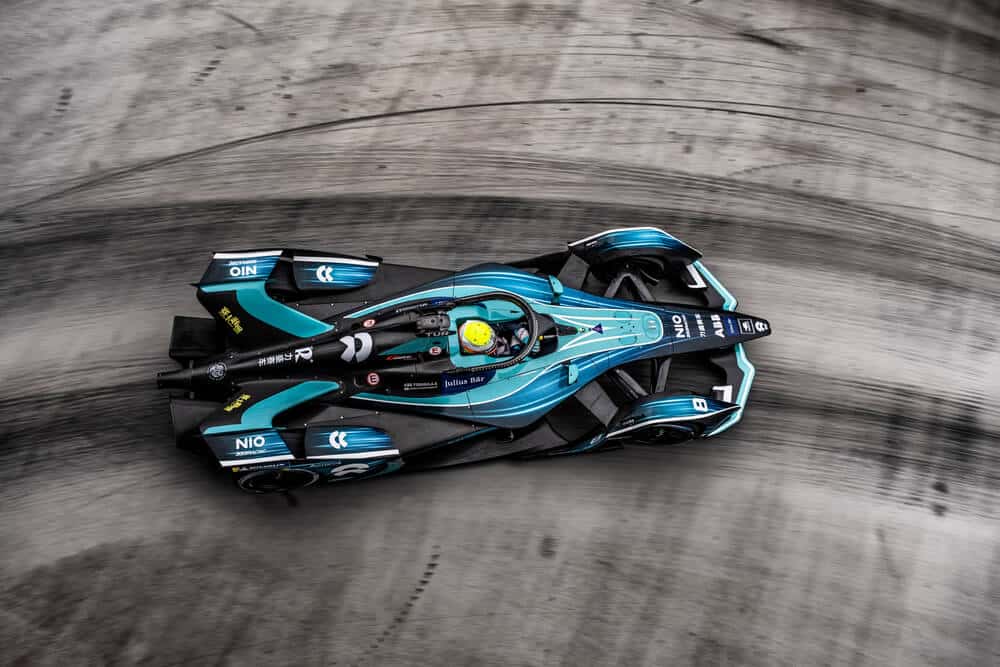
Frequently asked questions (FAQs) about Formula 1 and Formula E
Table of Contents
What is the difference between Formula 1 and Formula E?
The major difference between the two, apart from one being the pinnacle of motorsport championships and the other like the new kid in town, is that Formula 1 is fuel-driven while Formula E cars are racing towards a cleaner future with their all-powered electric engine. The table below categorizes the main differences between a Formula 1 car and a Formula E car.| Formula 1 | Formula E | |
|---|---|---|
| Chassis | Various Manufacturers | Spark Racing Technology |
| Power Unit | 1.6-liter turbocharged hybrid V6 | 54 kWh Battery |
| Weight | 798 kg | 900 kg |
| Length | 5500 mm | 5160 mm |
| Width | 2000 mm | 1770 mm |
| Max Power | 745+ kW / 1000+ HP | 250 kW / 335 HP (in Fanboost mode) |
| Top Speed | 340+ kph / 210+ mph | 280 kph / 174 mph |
| 0-60 mph | 2.6 seconds | 2.8 seconds |
| Race Length | 305 km / 190 miles | 45 mins + 1 lap |
Key Takeaways
Here is a list of some key differences between Formula 1 and Formula E:- Formula 1 car has a massively powerful 1.6L turbocharged V6 engine coupled with a hybrid system. On the contrary, the electronic motor is powered by a 28kWh battery in Formula E.
- Formula 1 cars generally weigh approximately 80kg lighter than Formula E, which weighs around 900kg.
- Formula 1 has a maximum speed of 210 mph, while Formula E cannot exceed 174 mph.
- Spark Racing Technologies is the sole manufacturer of Formula E. On the contrary, there are various manufacturers of F1, for instance, Mercedes, Ferrari and Renault.
- Formula E can go from 0-100km/h in 2.8 seconds, whereas Formula 1 reaches the same speeds in an impressive 2.6 seconds.
- Fuel engines power F1 cars, creating more power than electric motors. They have a horsepower of 1000+, while Formula E automobiles fire up around 335 horsepower.
What is the difference between Formula 1 and Formula E?
The major difference between the two, apart from one being the pinnacle of motorsport championships and the other like the new kid in town, is that Formula 1 is fuel-driven while Formula E cars are racing towards a cleaner future with their all-powered electric engine. The table below categorizes the main differences between the two.| Formula 1 | Formula E | |
|---|---|---|
| Chassis | Various Manufacturers | Spark Racing Technology |
| Power Unit | 1.6-liter turbocharged hybrid V6 | 54 kWh Battery |
| Weight | 798 kg | 900 kg |
| Length | 5500 mm | 5160 mm |
| Width | 2000 mm | 1770 mm |
| Max Power | 745+ kW / 1000+ HP | 250 kW / 335 HP (in Fanboost mode) |
| Top Speed | 340+ kph / 210+ mph | 280 kph / 174 mph |
| 0-60 mph | 2.6 seconds | 2.8 seconds |
| Race Length | 305 km / 190 miles | 45 mins + 1 lap |
Understanding a Formula 1 Car
Even though F1 automobile racing has roots in the European Grand Prix Championship of the 1920s, the 1950s was the decade of successful front-engined racing cars, especially in sports-car racing. A modern Formula 1 car can best be described as the peak of engineering excellence. With an engine, also known as a power unit, positioned behind the driver, a Formula 1 car is a single-seater, open cockpit, open-wheel formula racing car. The F1 cars must be constructed using the most advanced materials and techniques to withstand their remarkable physical strain during the world’s most popular motor racing sports. Let us dig deeper and see more of its specifications.Weight
F1 cars are mostly made from carbon fiber and other strong but lightweight materials. Including the driver and wheels, while excluding the fuel, the weight of an F1 car should not be less than 702kg or 1548lbs. Having a minimum weight of 150kg, the engine is the most massive component in an F1 car.Maximum power
The latest power plant in F1 cars is its most complex yet, with a massively powerful 1.6L turbocharged V6 engine coupled with a hybrid system that includes a petrol engine as well as electric power, better known as an energy recovery system (ERS). The whole thing, petrol and electric, put out 1000 horsepower, which is very high compared to normal road cars. Moreover, Formula 1 can produce around 680Nm of torque.0-100 km/h.
The petrol engine revs up to 15000 rpm with its 8-speed automatic gearbox, which means 0-100km/h in 2.6 seconds.Max speed
F1 cars are known to produce high speeds, making them the most powerful, most technologically advanced and fastest cars in the world. They have reached top speeds hitting a blistering 230mph or 340kph. The highest speed ever recorded for an F1 car was 246.9mph. Due to their high speeds, F1 cars take only 1.7 seconds to finish the century sprint.Fuel
Formula 1 car uses normal fuels with no specific power-boosting compounds. However, 10% of it must be advanced sustainable ethanol. They use about 75 liters of fuel per 100km. 110liters of fuel, at most, can be used in a race.Wheels
F1 cars are open wheels, which means they are exposed to the air and are situated away from the automobile. Pirelli is the official tire supplier for Formula 1 cars. F1 cars have smooth, slick 13-inch wheels with no treads to provide a better grip on the track surface in dry conditions. However, there are two more types of tires that the F1 teams can utilize, one being the intermediate tire set for light rain or dampness and the full wet tire set for heavy rain.Noise
An automobile may seem faster and more powerful solely because of the sound it produces. A formula 1 car typically generates very loud sound reaching up to 138 decibels of sound, just below the level that causes permanent hearing loss.Steering Wheel
The steering wheel of a Formula 1 car consists of more than two dozen buttons, knobs, rotary dials, menus, displays and LEDs, which are equipped to perform various functions such as changing brake pressure, changing gears, fuel adjustment and calling the radio.Braking System
The braking system of an F1 car comprises brake discs, calipers, pedals and master cylinders. All the components are linked by pipework and with a brake-by-wire unit controlling the rear brakes. The brakes limit their ability to deliver even greater performance, even with the deacceleration. The brake discs are 32mm thick on the front and 28mm on the back. There are up to 1480 ventilation holes in the discs, each 2.5mm in diameter.Manufacturer
Due to the complex nature of Formula 1 engines, only Mercedes, Ferrari, Renault, and Honda currently manufacture them.Race Criteria
Formula 1 races along custom-built out-of-town circuits, which are wide, long, fast, and complex. An average distance of 300 kilometers is covered by a Formula 1 driver in a single race. In an F1 team, there are two drivers, each with one car. Formula 1 Grand Prix stretches between 3 days, where practice and qualifying occur in the days leading up to the race.Pit Stops
Pits stops are an integral part of any race. Depending on various factors, such as track conditions, weather and car damage, cars take between one to three pit stops in a race. However, pit stops are made primarily for changing tires, and F1 drivers must stop at least once in a race.
The major difference between the two, apart from one being the pinnacle of motorsport championships and the other like the new kid in town, is that Formula 1 is fuel-driven while Formula E cars are racing towards a cleaner future with their all-powered electric engine.
Understanding a Formula E car
Sustainable, innovative, silent and clean, Formula E cars are known to be the world’s most efficient racing cars. With the help of innovation and technology, Formula E aims to promote a cleaner and better future. With Its launch in 2014, it became the world’s first fully-electric single-seater racing automobile. Since then, it has garnered the attention of many major brands and motorsport enthusiasts. Let us look at the specifications of Formula E cars to understand how they differ from Formula 1 cars.Weight
Most of its parts are made of composite materials like carbon fiber. Excluding the driver and battery, a formula E car weighs a minimum of 900kg.Max power
The power unit consists of three main base components, the big lithium-ion battery currently standard in all Formula E cars, the Motor Generator Unit (MGU) and the power inverter. The electric motor can deliver up to 335 horsepower. Additionally, Formula E can produce 140Nm of torque. Unlike F1, Formula E cars can produce their torques instantly.0-100 km/h
With instant power delivery, Formula E can rev up to 17500rpm with their 5-speed sequential gearboxes, making them go 0-100km/h in just 2.8 seconds.Max speed
With the aerodynamic shape of the car and the 250kW electric motor, Formula E cars can reach a maximum speed of around 174 miles per hour (280kph). Moreover, it takes 3 seconds for Formula E cars to finish the century sprint.Fuel
Since Formula E cars solely run on electricity, powered by an aggressive electric motor which is charged by a 28kWh battery, it does not require any fuel. Thus, making them less costly to maintain and operate.Wheels
Michelin Pilot Sport EV tires are exclusively made for Formula E cars. It’s the only 18-inch racing tire to feature in any single-seater world championship. Additionally, it is the only hybrid tire engineered to perform on any surface in wet and dry conditions. Formula E cars are partially open-wheeled, much better known as having wheel arches.Noise
Formula E cars have a high-pitched whining sound that primarily comes from the gearbox. Compared to an F1 car, it produces a more modern and futuristic noise level of around 80 decibels, slightly higher than the average gas-powered car.Steering Wheel
The car has a non-assisted rack and pinion steering system, which consists of a gear change mechanism, clutch paddles, and a marshaling display. The driver can access data such as tire pressures, brake pressures, the battery’s charge level, lap time, etc. The driver can also monitor the level of energy the car is using. Furthermore, the ATK button, also situated on the steering wheel for attack mode, gives drivers 35kW of extra power in designated zones on the track.Braking System
Formula E cars have two separate hydraulic systems operated by the same pedal. The braking system comprises carbon discs and pads, 4-piston monobloc aluminum calipers, a single-stage tandem pump, and an aluminum bell. The discs and pads on a Formula E car are not as thick as those in F1 automobiles. The discs are 24mm on the front and 20mm on the rear, with around 70 ventilation holes on the front and 90 on the back.Manufacturer
The chassis, along with the car’s other components such as brakes, suspensions, main battery, tires, and bodywork, are all assembled by Spark Racing Technology. At the same time, Renault puts together the electric components in a Formula E automobile. Unlike F1 cars, all Formula E cars are identical.Race Criteria
Formula E car races are held in small street temporary circuits in some of the largest cities of the world, including Paris, Mexico, San Diego, Berlin, and New York. Formula E drivers cover a much shorter distance than F1, somewhere between 90km to 150km. The standard time of a single race is 45 minutes plus one lap. A Formula E team is assigned two cars each for two separate drivers. Additionally, each event of Formula E has two practice sessions, a qualifying session, and the race showdown in one day.Pit Stops
Since the power batteries didn’t have enough charge to complete the full circuit, Formula E drivers switched to their second car during a pit stop. However, this has changed from the last season, and the battery doesn’t die out in between the race, making it possible for drivers to complete without having to stop at a pit stop.
Frequently asked questions (FAQs) about Formula 1 and Formula E
Is Formula 1 faster than Formula E?
With the specifications of both cars, Formula 1 is much faster than Formula E. Acceleration, braking, cornering, maximum speed, and distance covered are all much faster in Formula 1 cars.Is Formula E going to replace Formula 1?
Even with the gaining popularity of Formula E, it is unlikely for it to replace Formula 1, which racked up 1.5 billion TV viewers in 2021. The two are most likely to coexist.What is the difference between Formula E and Formula 1?
The major difference between the two automobiles is that Formula E is a fully automatic car. In contrast, Formula 1 cars manifest hybrid cars with internal combustion engines powered by high-octane fossil fuels.What top speed does a Formula E car have?
The top speed of Formula E cars is estimated to be 225km/h, which is relatively slower than most top-tier single-seater cars.How long do Formula E batteries last?
Thanks to technological innovation, the batteries of Formula E cars can now last up to 45 minutes. The cars can complete a Formula E race, which typically lasts 45 minutes, without drivers needing to change cars halfway through the race.Is Formula E related to Formula 1?
The only common thing between the two is that they are both governed by The Fédération Internationale de l’Automobile (FIA); otherwise, they are both separate series and unrelated.Conclusion
Many people confuse F1 and Formula E cars as being the same, as they may appear similar. However, they are entirely different in many aspects. While everyone across the globe is drawn toward the unadulterated power of monstrous engines in a hyper-fast Formula 1 car, Formula E’s sustainability and advanced technology give it a headstart in the race to become future-ready. The bottom line? Both automobiles have distinctive features that appeal to different groups of peopleArticle sources
- https://en.wikipedia.org/wiki/Formula_E_car
- https://en.wikipedia.org/wiki/Formula_One_car#:~:text=A%20Formula%20One%20car%20
- https://www.forbes.com/sites/jamesmorris/2022/05/07/formula-1-could-be-all-electric-by-2035-says-fomula-e-boss/?sh=4c422d5c6385
- https://www.sciencefocus.com/advertisement-feature/the-anatomy-of-a-formula-e-car/
Is Formula 1 faster than Formula E?
Is Formula E going to replace Formula 1?
What is the difference between Formula E and Formula 1?
What top speed does a Formula E car have?
How long do Formula E batteries last?
Is Formula E related to Formula 1?
Conclusion
Many people confuse F1 and Formula E cars as being the same, as they may appear similar.
However, they are entirely different in many aspects. While everyone across the globe is drawn toward the unadulterated power of monstrous engines in a hyper-fast Formula 1 car, Formula E’s sustainability and advanced technology give it a headstart in the race to become future-ready.
The bottom line? Both automobiles have distinctive features that appeal to different groups of people
Article sources
- https://en.wikipedia.org/wiki/Formula_E_car
- https://en.wikipedia.org/wiki/Formula_One_car#:~:text=A%20Formula%20One%20car%20
- https://www.forbes.com/sites/jamesmorris/2022/05/07/formula-1-could-be-all-electric-by-2035-says-fomula-e-boss/?sh=4c422d5c6385
- https://www.sciencefocus.com/advertisement-feature/the-anatomy-of-a-formula-e-car/

